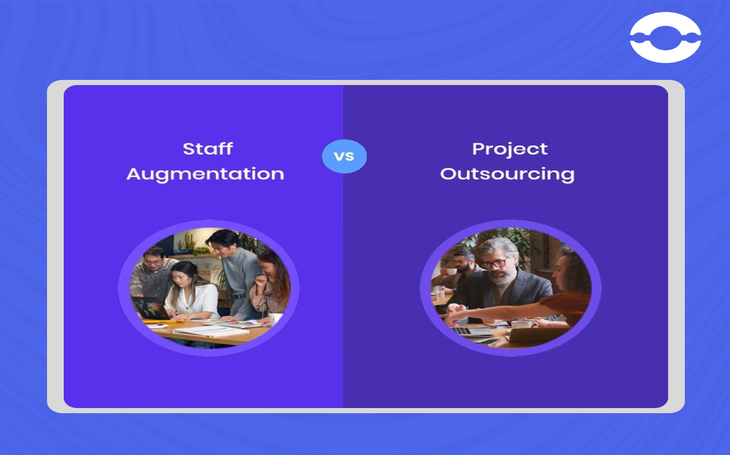
When it comes to innovations, contemporary times have an abundance. Companies are coming up with products that ease human life. For product development, businesses sometimes take the help of outsourcing engagement models – Staff Augmentation vs Project Outsourcing.
The major two outsourcing models are Staff Augmentation and Project Outsourcing. While the former involves hiring professionals, the latter means hiring a third-party vendor to work on a particular project.
Through these models, businesses intend to eliminate personnel costs and speed up a project timeline. In addition, they seek expertise beyond the scope of what their already existing resources possess and offer.
Although businesses are provided with domain expertise and skilled professionals under both these options, there are some differences between the two models.
Read through the blog to get an understanding of staff augmentation v/s project outsourcing and choose the approach that most effectively caters to your staffing and software development needs.
Staff Augmentation
Businesses augment staff temporarily to fill specific expertise and skill gaps in the company. Through staff augmentation, the outsourcer adds a third-party team or specialists to the in-house team. These specialists work on the premises of the buyer for the complete duration of the project. Workers employed under staff augmentation are employees of the company till the completion of the project.
Staff Augmentation allows businesses to reduce employment costs and enhance operational efficiencies. It assists you with finding the right specialist to progress with your project or complete it effectively.
Benefits of Staff Augmentation:
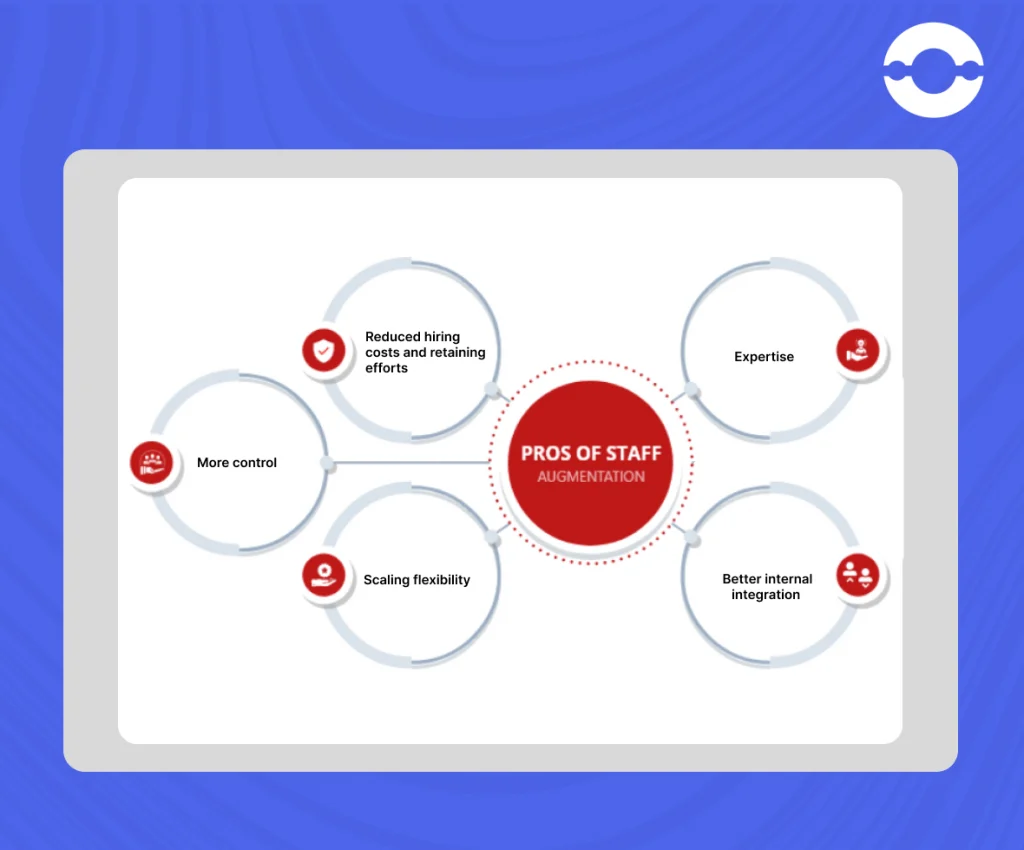
1. More control
With the physical presence of hired specialists on-premises, businesses have direct oversight over the working of a specialist and the progress of the project. Furthermore, companies have the liberty of involving the augmented staff in multiple projects, according to the business requirements.
2. Scaling flexibility
Through the staff augmentation model, businesses enjoy the flexibility of scaling up or scaling down their staff/teams. In case a project expands or contracts over time, or timelines change, a business doesn’t need to worry about hiring or firing additional employees. You simply pick the most suitable outsourced people for your project and scale according to business needs.
3. Reduced hiring costs and retaining efforts
Since administrative duties are looked after by IT staff augmentation providers, a business is not saddled with recruiting, hiring, retaining, and then incurring expenses on a full-time employee. Furthermore, the time and effort put into employee retention are saved through staff augmentation.
4. Expertise
With staff augmentation, a business does not hire a skilled and experienced candidate but chooses someone who matches up to or exceeds their expectations. This is ensured since with outsourced staff, businesses skip that trial-and-error stage that might come with lower-level in-house hires.
5. Better internal integration
The staff augmentation model enables the smooth integration of external hires into an internal team for a project, as opposed to working with a third-party vendor team. In the latter case, there might arise some compatibility issues rooted in cultural and technological differences between the parties.
Drawbacks of Staff Augmentation:
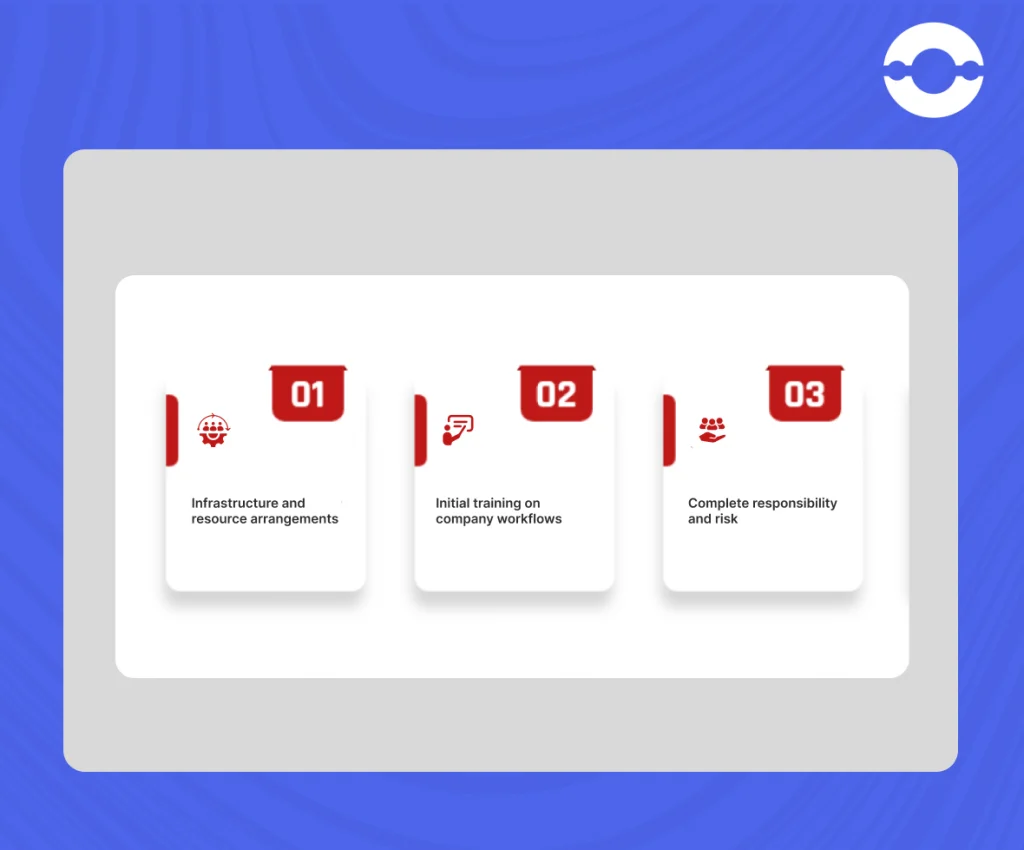
1. Infrastructure and resource arrangements
Sometimes under the staff augmentation model, the company needs to make necessary infrastructure and managerial changes/additions. Businesses need to hire or reallocate project managers to manage the temporary hires and even provide additional office space according to the size of the augmented staff.
2. Initial training on company workflows
Although you get the most skilled and proficient hires, some resources still need to be devoted to training, as well as educating them about your company culture, operations, and work ethics. This might sometimes slow productivity down, in the initial period, until the outsourced staff gets a hang of your internal business workflows and protocols.
3. Complete responsibility and risk
Through staff augmentation service, businesses just get the required resources for a third-vendor company. Therefore, the complete development process, quality control, and hitting the deadlines, are to be looked after by businesses opting for augmented staff services.
Project Outsourcing
Under project outsourcing, a business takes the help of an external firm to complete its projects using the latter’s resources. Sometimes only specific aspects of the project may be outsourced to an external team while other times, the full product development cycle may be outsourced. In project outsourcing, the team is staffed and handled by the outsourcing service provider.
For companies whose IT teams already have a lot on their plate and want to distribute some workload, or those businesses that lack a longer time window for a project or want minimum internal management, IT project outsourcing should be the preferred choice.
Project Outsourcing benefits:

1. Effective project management
In the project outsourcing model, the entire project is managed by experienced, proficient industry outsourcing service providers. Furthermore, the training required for an outsourcing company to effectively complete your project would most likely be little or none at all.
CIO magazine research stated that ‘CIOs find data science and analytics positions most challenging IT jobs to fill’.
The outsourced project is carried out more effectively as outsourcing companies may leverage their internal economies of scale within their key competencies for a project, giving optimal results.
2. Reduced costs
As per the project outsourcing model, the responsibility of putting together, training, and handling a remote team falls on the vendor. Furthermore, delivery of the final product and meeting the quality standards, are also looked after by the vendor. Therefore, there is no additional management overhead for additional employees with project outsourcing.
In fact, in a survey by Statistics Brain Institute, 44% of American companies that participated said reducing expenses was the key reason for choosing the project outsourcing model.
3. Fewer turnaround times
Under project outsourcing, the velocity of teams collectively is comparatively higher, and therefore, project turnaround time is relatively less. While deadlines are often more flexible and negotiable with in-house/internal teams, an outsourcing company’s success is decided by its timely deliveries.
4. Focus on core business functions
When a business outsources the product development cycle, they have a window to focus on more crucial, core aspects of the business. Project managers have the room to free up time for in-house employees by outsourcing some development tasks.
By distributing the workload of in-house teams, the utilization of onsite employees becomes more flexible. This way they can be redeployed to work on high-priority projects or projects that are focused on or around the company’s area of expertise.
5. Scalability
If a project grows over time or if additional resources are required, it’s easy to scale using the project outsourcing model.
6. Risk sharing
Usually, under the project outsourcing model, any project delays, failures, or liabilities that may arise are the project outsourcer company’s risk.
Project Outsource drawbacks:
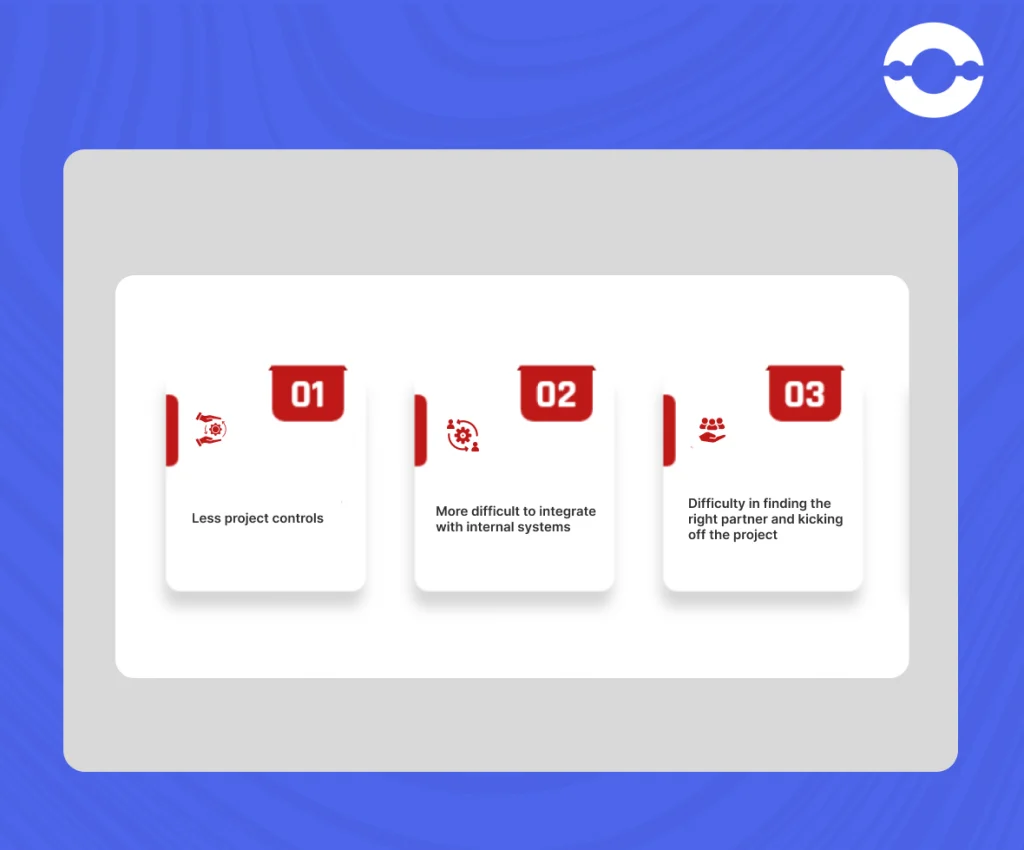
1. Fewer project controls
Since the control of the project lies with the outsourced party, businesses lose direct managerial control over the project. Outsourcing IT projects means leaving the project goals execution, workflows, and delivery deadlines, all up to the outsourcing company. In case of communication gaps, this would turn the whole project and experience around.
2. More difficult to integrate with internal systems
It can be more difficult to integrate outsourced projects with internal systems. This is because it requires the business to align with the outsourced IT team.
Because you give up direct oversight with this model, you may run into some quality issues with the final product, which can harm productivity, as well as general team morale as employees, managers, and outsourcing vendors try to figure out who is responsible for these issues. Coding errors that fall short of your firm’s rigorous development standards, undisclosed technical debt, or other technical problems originating from an outsourced development team can be time-consuming and difficult to resolve.
3. Difficulty in finding the right partner and kicking off the project
Companies often experience a hard time looking for the right and most suitable outsourcing companies. It is important to invest time in finding the same and be in constant touch or engaged all along the development process to get optimal results.
Furthermore, all aspects and components of the outsourced project need to be finalized during the planning stage, and legalities and documentation must be done and dusted, all before the project kicks off.
Staff Augmentation vs Project Outsourcing: A comparative analysis
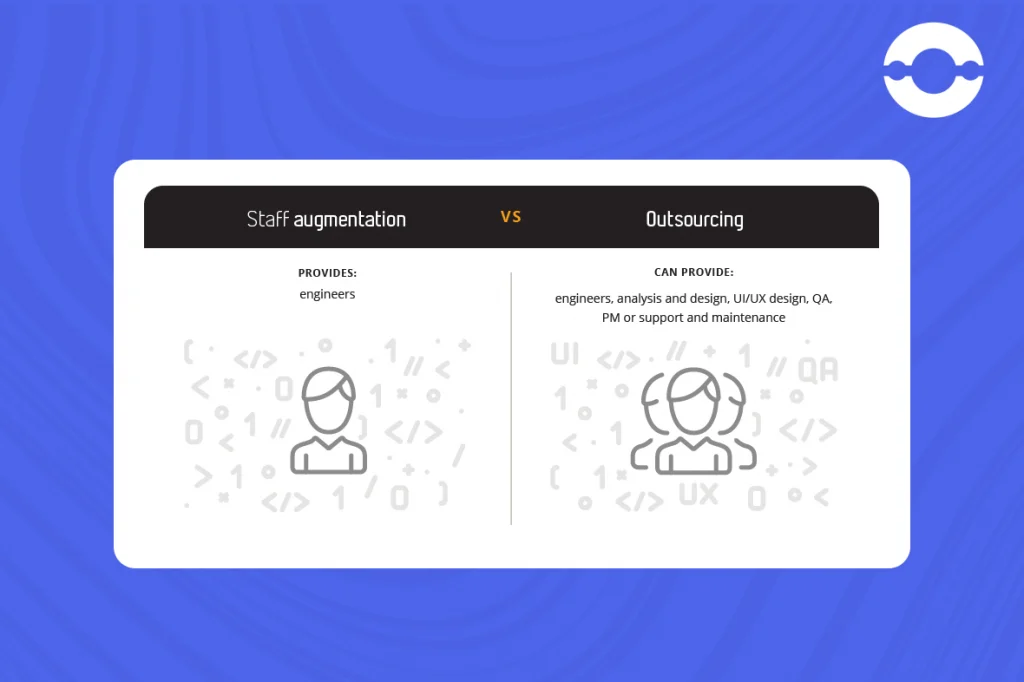
| Parameters | Staff Augmentation | Outsourcing |
| Costs involved | The cost of hiring and domain training the augmented staff is incurred by the service provider. Additional Infrastructure and managerial costs are taken care of by the business in case of onsite staff augmentation. Comparatively a lesser costly option, on a per hourly basis. | All fixed as well as variable costs involving hired workers are incurred by outsourcing the vendor. Infrastructural equipment and project resources are arranged by the vendor. Relatively costlier option, on a per hourly basis. |
| Suitability | Onboarding is a quick process client gets easy and on-demand access to required resources and skills. | Suitable for projects that need end-to-end expertise, or are huge in scope. Small projects are less-cost effective under this model. Both short-term and long-term objectives can be fulfilled through this model. |
| Project management | Project management is with the business. No need for constant communication. | Project management is with the third-party vendor. Continuous communication is vital for this model. |
| Onboarding | Onboarding is a quick process client gets easy and on-demand access to required resources and skills. | Projects take time to take off since both parties have to agree on the idea, development process, deadlines, and legalities. |
Which is the best model for your project?

Staff augmentation should be opted for in projects that only need certain expertise and skill gaps to be filled or for projects that are not very crucial. Small projects are catered well by staff augmentation services as they fulfill the staffing needs for the duration of a whole project, certain stages, or for a final software review. With direct managerial control, augmented staff resources are able to integrate well with the internal teams and businesses are able to scale those resources easily.
While project outsourcing model should be chosen when a project is large in scope and needs handholding by experts all through the product development cycle. In this case, a business should be comfortable with giving up direct control of the project. Furthermore, with project risk shared with the outsourcing vendor, businesses save hiring, training, and managerial costs, get a higher domain and industry expertise and experience for their project, and free up the in-house employees for other crucial business tasks.
While both models, Staff Augmentation and Project Outsourcing, help businesses to complete their projects effectively, there are significant differences in the nature and extent of engagement under both these models. Their suitability entirely depends upon the scope and expertise required for your project as well as the budget allocated for the project.
BigOhTech provides both, dedicated development teams or developers and also outsourced product development services. We ensure that client project is completed within the decided time, meeting the quality standards and the final product aligns with business goals.
FAQ
While staff augmentation can mean just hiring resources from the third-party vendor to work on a project, team augmentation means hiring a full team for a project.
Staff augmentation is hiring specialists or teams from third-party vendors to work on a project onsite. Project-based consulting on the other hand means consulting a third-party vendor for operational, strategic, or technical understanding of a project.
While staff augmentation means hiring specialists or a team from an outsourcing company to carry out projects on-premises, with internal teams, sub-contracting means assigning, or outsourcing, part of any task under a contract to any other party known as a subcontractor.
The different types of project outsourcing available are professional outsourcing, IT outsourcing, manufacturing outsourcing, project outsourcing, process outsourcing, and operational outsourcing.
The best way to find a good project outsourcing company is to look for options on professional networking sites like LinkedIn, or freelance sites or hire a company through referrals.
While hiring resources on a temporary basis, working with the internal team on a payroll different from theirs, from a third-party vendor is called staff augmentation, if the resources are hired on a permanent basis, then the same is called staffing.




